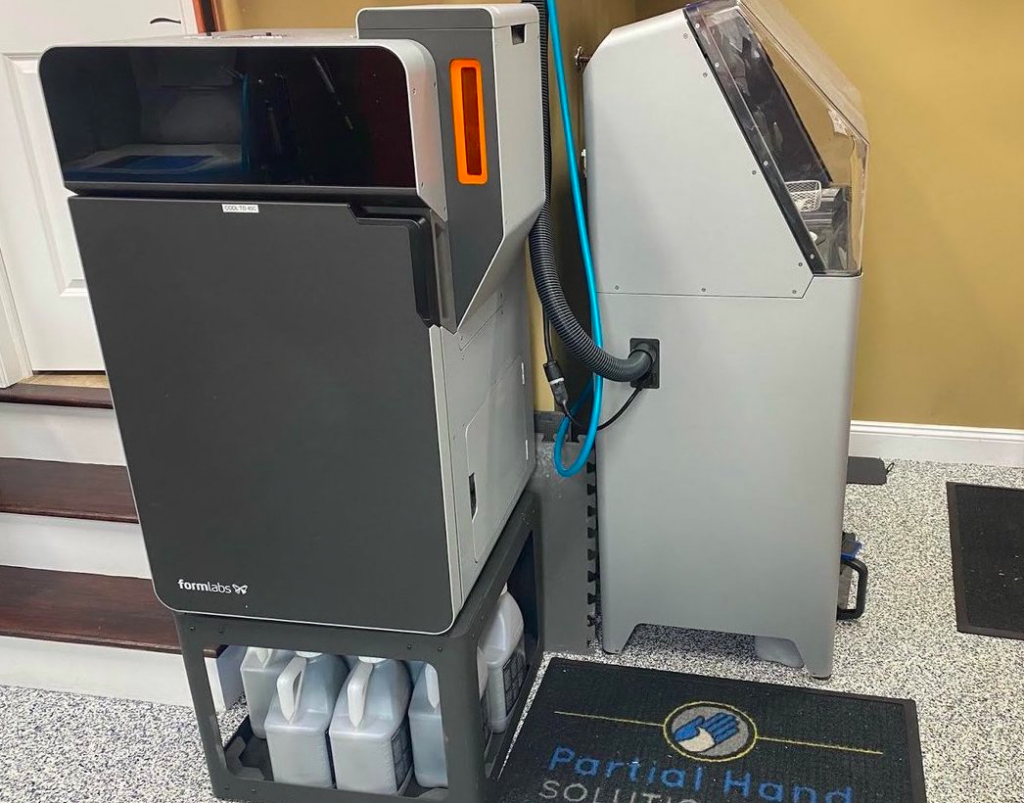Advanced prosthetics manufacturer Partial Hand Solutions (PHS) has leveraged Formlabs’ new Form 1 3D printer to optimize its artificial limb manufacturing process.
Instead of outsourcing the production of its pediatric M-Finger and Elbow implants to an injection molding firm, PHS now uses the Form 1 to create patient-specific prosthetics in-house. By switching to Formlabs’ recently-launched system, the company has managed to 3D print more durable nylon parts cost-effectively while cutting their lead times down from two weeks to just a couple of days.
“Waiting two days for a full build platform of printers blows away the weeks I used to wait for my injection molding parts to arrive,” said Matthew Mikosz, Founder of Partial Hand Solutions. “Using the Fuse 1 has expanded my horizons. Now I’m thinking about how I can improve my work and create better patient outcomes.”

Partial Hand’s SLS problem
Since 2007, PHS has worked to push amputee technology boundaries and create prosthetics with new functionality for those with partial hand amputations. Given that many of the firm’s clients are either active soldiers or children with extensive injuries, it also considers the rapid delivery of customized implants vital to its business.
However, by outsourcing production, PHS has only previously been able to offer its products in five set sizes, which hasn’t accounted for patient needs or allowed them to maximize potential mobility. What’s more, the company ran trials of SLA, FDM, and injection molding processes before but found that affordable patient-specific products remained out of reach.
In particular, the firm saw potential in SLS 3D printed nylon parts, but according to Mikosz, their up-front costs meant that they weren’t attainable until the Fuse 1 came along. “I’ve always wanted an SLS printer, but they are unattainable at their current price,” said Mikosz. “The Fuse 1 is perfect for small businesses.”

Optimized prosthetic production
By adopting the Fuse 1 and Fuse Sift together, Mikosz says that his company has been able to establish a new, more efficient production workflow. For instance, using the Formlabs machines to produce the controllable prosthetic ‘M-Finger,’ has enabled PHS to achieve a low powder refresh rate, reducing its overall cost per part.
In fact, by packing the system’s build area, Mikosz claims that he has been able to print 160 fingers in just two days. Reducing the amount of moving part spacing has also allowed him to create functional joints with little post-processing, something that’s not possible using other techniques, without adding time-consuming steps.
Additionally, PHS’ additive digit previously required the use of a carbon fiber socket to connect to a patient’s body. Using the Fuse 1, the company is now able to fabricate the prosthetics using polymers instead, making them more affordable and customizable than before, without affecting their final surface quality.
“I’m impressed with the ability to print functioning joints. I’m never going to need to outsource these parts again.”
As a final demonstration of the Fuse 1’s capabilities, PHS 3D printed a prosthetic elbow for a ten-year-old patient. Traditionally, pediatric amputees are forced to use standard adult-sized artificial limbs, which can prove heavy for children as they grow into them. Using its new 3D printer, on the other hand, the company was able to fabricate a considerably lighter nylon-based alternative.
On the production side, Mikosz found that the shoulder was even easier to print and clean than the fingers due to its size, lack of crevices and reduced amount of leftover powder. Although he didn’t reveal precisely how long it took to print, Mikosz added that it was longer than before, but that this was “appropriate given its size.”
While PHS has essentially been a pre-launch beta user, the case study at least demonstrates the Fuse 1’s efficacy at making industrial SLS more accessible. In the longer-term though, it remains to be seen how Formlabs’ new machine will stack-up against the industry’s other established names in the desktop SLS arena.
3D printed pediatric prosthetics
Although 3D printing artificial limbs for children represents a noble cause, it’s by no means a novel one, and a number of charities and firms have created their own in recent years.
Ambionics’ 3D printed artificial arms, which are specifically designed for juvenile use, entered initial trials as long ago as 2017. Using a Stratasys 3D printer, the prosthetics are powered by hydraulics rather than electrical gears and motors, which can prove dangerous to children.
On a more experimental basis, researchers at the UK-based University of Lincoln have 3D printed a sensor-operated artificial arm. The prototype prosthetic is specifically designed to be a lightweight alternative artificial limb, that addresses the needs of children under two-years-old.
Elsewhere, the Syria Relief charity has made a plea to the UK government’s Department for International Development, to provide funding for 3D printed prosthetic limbs. According to the doctors working as part of Syrian relief efforts, the implants could be produced more quickly and cheaply using additive technologies.
To stay up to date with the latest 3D printing news, don’t forget to subscribe to the 3D Printing Industry newsletter or follow us on Twitter or liking our page on Facebook.
Are you looking for a job in the additive manufacturing industry? Visit 3D Printing Jobs for a selection of roles in the industry.
Featured image shows one of Partial Hand Solutions’ newly 3D printed prosthetic sockets. Photo via Partial Hand Solutions.



